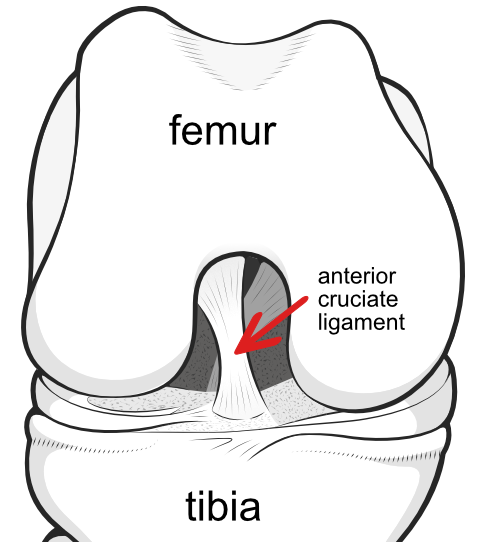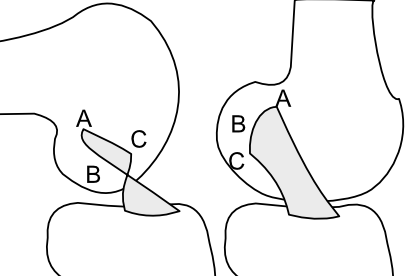The anterior cruciate ligament (ACL) is one of two strong ligaments supporting the knee joint by binding the femur and tibia together while crossing over one another inside the knee.
 Page updated July 2024 by Dr Sheila Strover (Clinical Editor)
Page updated July 2024 by Dr Sheila Strover (Clinical Editor)

The anterior cruciate ligament is the one in the front, while at the back lies the posterior cruciate ligament.
What does the anterior cruciate ligament do?
The ACL is a key stabiliser of the knee joint - it prevents the tibia from excessive forward motion relative to the femur, and also prevents too much inwards twisting.
 The ligament is comprised of two functional bundles - the anteromedial and the posterolateral bundle. The illustration shows how the load is distributed differently in flexion and extension. The wide footprint and the complexity of how loading differs in the two bundles have given surgeons a lot of headaches in their attempts over the years to reproduce the anatomy during a reconstruction procedure.
The ligament is comprised of two functional bundles - the anteromedial and the posterolateral bundle. The illustration shows how the load is distributed differently in flexion and extension. The wide footprint and the complexity of how loading differs in the two bundles have given surgeons a lot of headaches in their attempts over the years to reproduce the anatomy during a reconstruction procedure.
-
Quote from peer-reviewed paper:
"....The anterior cruciate ligament (ACL) is considered the primary passive restraint to anterior translation of the tibia on the femur, and it provides rotational stability to the knee in both the frontal and transverse planes...."
Citation: Raines BT, Naclerio E, Sherman SL. Management of Anterior Cruciate Ligament Injury: What's In and What's Out? Indian J Orthop. 2017 Sep-Oct;51(5):563-575. doi: 10.4103/ortho.IJOrtho_245_17. PMID: 28966380; PMCID: PMC5609378.
Factors influencing anterior cruciate ligament injury

Sport is commonly involved when there is a cruciate ligament injury.
Although common in athletes, injury is often non-contact in nature, ie not involving impact. Here, the twisting of the limb with the foot on the ground may be enough to snap the ligament.
However, there are a number of factors that predispose to anterior cruciate ligament injury - both anatomical and also related to the mechanism of injury.
-
Quote from peer-reviewed paper:
"...multiple risk factors act in combination to influence the risk of ACL injury...Anatomic features, such as a decrease in femoral notch width, a decrease in the depth of concavity of the medial tibial plateau, and an increase in the posterior-inferior-directed slope of the tibial plateau, act in combination to increase the risk....Females are at increased risk...."
Citation: Smith HC, Vacek P, Johnson RJ, Slauterbeck JR, Hashemi J, Shultz S, Beynnon BD. Risk factors for anterior cruciate ligament injury: a review of the literature-part 2: hormonal, genetic, cognitive function, previous injury, and extrinsic risk factors. Sports Health. 2012 Mar;4(2):155-61. doi: 10.1177/1941738111428282. PMID: 23016083; PMCID: PMC3435909.
-
Quote from peer-reviewed paper:
"....Noncontact mechanisms account for 60%–70% of ACL injuries....."
Citation: Raines BT, Naclerio E, Sherman SL. Management of Anterior Cruciate Ligament Injury: What's In and What's Out? Indian J Orthop. 2017 Sep-Oct;51(5):563-575. doi: 10.4103/ortho.IJOrtho_245_17. PMID: 28966380; PMCID: PMC5609378.
What damage occurs during injury?
At injury there may be a loud 'pop!' followed by immediate pain and rapid swelling and difficulty walking.
The nature of the injury is not always the same in different patients. Sometimes the ligament is sprained, rather than completely torn. Younger patients tend to have an avulsion from the bone, without any actual tear through the substance of the ligament itself.
-
Quote from peer-reviewed paper:
"....The ligament may get avulsed from any one of its attachments. The severity may depend on the mechanism of injury ranging from a sprain to a complete tear of the ACL. There may even be an avulsion of a small piece of bone accompanying the ligament, which can be visualized on the X-rays. It can occur as an isolated ACL tear or involvement of a multi-ligamentous injury...."
Citation: Shom P, Varma AR, Prasad R. The Anterior Cruciate Ligament: Principles of Treatment. Cureus. 2023 Jun 11;15(6):e40269. doi: 10.7759/cureus.40269. PMID: 37448400; PMCID: PMC10336184.
What are the signs and symptoms of an ACL tear?
The primary symptom of an incompetent ACL is knee instability. After the swelling comes down it may be possible to walk in a straight line, but twisting movements will cause feelings of instability.
Instability can be assessed by the surgeon with tests that pull the tibia forwards in relation to the femur - anterior drawer test, pivot shift test, Slocum test. The degree of abnormal movement can be quantified with instruments such as the KT 2000.
-
Quote from peer-reviewed paper:
"....The physical examination has long been the mainstay of orthopaedic evaluation and diagnosis. The Lachman and anterior drawer tests are both clinically useful and highly specific, although the anterior drawer is less sensitive than Lachman. However, the lever test should have a more limited role, and findings should be interpreted with caution....."
Citation: Kulwin RL, Schmidt GJ, Snyder DA, Klitzman RG. Clinical Examination in the Diagnosis of Anterior Cruciate Ligament Injury: A Blinded, Cross-sectional Evaluation. J Am Acad Orthop Surg Glob Res Rev. 2023 Feb 8;7(2):e22.00123. doi: 10.5435/JAAOSGlobal-D-22-00123. PMID: 36758231; PMCID: PMC9915950.
Cruciate injury - options for management
Depending on the patient's age, there are a number of options for management.
Forum discussions
- "Anatomic Double Bundle ACL Reconstruction - A Mistake?"
Patients discuss whether or not a double-bunder ACL reconstruction offers benefits.
 2023 - Primer -
2023 - Primer -